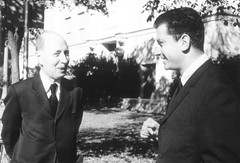Anyone who is familiar with Clay Shirky’s writing won’t be surprised to hear that in his new book Here Comes Everybody, he does a very nice job of discussing how recent technological innovations are allowing for more and more “organizing without organizationâ€. The book is a great mix of engaging descriptions about examples of how people come together in the pursuit of various goals and interests, and a deeper more conceptual examination of how such phenomena are changing in light of recent advances in technology.
I was invited to participate in a discussion of this book over on the TPM Café Book Club and am sorry to come to the conversation so late due to some travel having thus missed out on much interesting back-and-forth. Nonetheless, I wanted to add a bit to the conversation.
The issue I want to raise has to do with questions of inequality like much of the earlier discussion, although I approach this from a somewhat different angle than what’s been presented. While there is no question that new opportunities are allowing more folks to organize and more voices to be heard, they seem to privilege those already in more advantageous positions. I’d like to see more discussion of what circumstances in particular allow those with fewer resources to benefit from these new opportunities.
Let me take a step back as I describe where I am going with this. I will start by approaching it from the point of view of what ends up being a successful organizing (“without organizationâ€, that is:), where success is understood as intended levels of engagement by participants and the extent to which goals are accomplished.
What is it that makes one effort more successful than another? Why does rallying people around one issue result in so much more active participation than getting people excited about another matter? Is it not so much about the topic, rather, about the organizing that yields a different outcome? And if it is the latter then while traditional organization may no longer be necessary, it’s worth thinking about what aspects of new forms of organizing yield more or less successful outcomes.
Success with organizing is related to attention allocation. As Herbert Simon so aptly noted many years ago:
“What information consumes is rather obvious: it consumes the attention of its recipients. Hence a wealth of information creates a poverty of attention, and a need to allocate that attention efficiently among the overabundance of information sources that might consume it.†(1971)
New tools don’t change the fact that there are only so many hours in the day and so much attention that people have to give to any one type of activity. So who with what topic or goal has more of a chance at attracting attention?
This is where inequality comes in: Those more likely to attract attention to their content and activities are those who are already more privileged in one way or another. For example, those with more skills in understanding the new tools have a better chance of reaching out to and mobilizing enough initial interest to achieve beneficial outcomes than those who lack an understanding of these new opportunities. Alternatively, those with people in their networks who have the necessary skills (and time) will have a better chance at this than those who lack knowledgeable friends and family.
This is precisely the issue at hand concerning the story in Clay’s book regarding the lost/stolen cell phone and what followed in tracking it down. At the Supernova 2008 conference where Clay and I both spoke earlier this week, an attendee told a very similar story of his own, although this concerned a stolen laptop. The point is that Clay is right, such situations are increasingly common. However, like the woman in the book, the man at the conference was also one with considerable resources – not just financial, but also in terms of human and social capital – that likely made him a good candidate for benefiting from new tools.
I don’t mean to suggest that Clay ignored these issues of inequality in the book as he explicitly offers relevant caveats throughout the writing. Nonetheless, I still think the issue is worth highlighting as I think it is a crucial part of the story that is not understood very well and deserves more discussion.
While it is certainly the case that new technologies, tools and services are leveling the playing field, existing societal position and resources still matter. The question is: when do they matter more or less? Under what circumstances do people with less resources still manage to benefit from the new tools in ways that would have been difficult earlier? What are the examples of mobilization that do not involve people with PhDs, ones with noteable techie know-how or one’s with considerable financial resources either themselves or among those in their networks? There are such examples, certainly, but it would be interesting to see systematically what it is that unites them. What commonality is there among such cases that suggests a true leveling of the playing field that goes beyond allocating more opportunities to those who are already considerably privileged? (On a sidenote, these issues are similar to the ones I raised while discussing Yochai Benkler’s book The Wealth of Networks.)
Because the book focuses on examples of successful organizing, it is hard to discern why some attempts at it fail. (To be sure, Clay also discusses failed projects, for example, in the open-source software movement, but his main focus is the overall effect of such sofware on the industry as a whole.) Of course, failures are harder to find, especially lacking any organization of such information. Nonetheless, a deeper exploration of this side of things would help in understanding the extent to which the playing field is truly being leveled across all societal segments thanks to emerging new tools.





 I have a feeling someone at Amazon has also read
I have a feeling someone at Amazon has also read